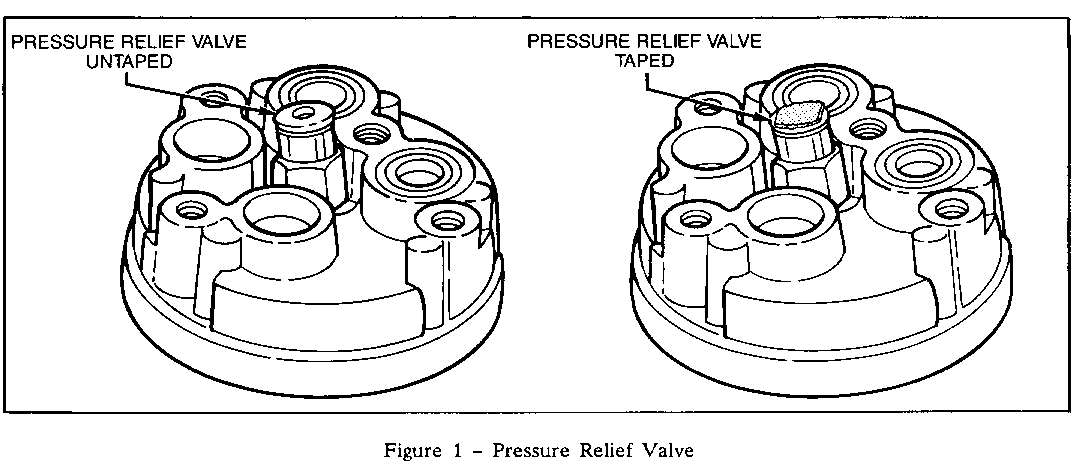A/C SYSTEM HIGH PRESSURE RELIEF VALVE ('BLOW-OFF')

VEHICLES AFFECTED: 1989 C
Some 1989 DeVille and Fleetwood A/C systems may experience an insufficient cooling or system condition due to refrigerant "blow-off" at the pressure relief valve found on the rear head of the compressor. Refer to Figure 1. This may be caused by a knock-out slug (from the muffler) becoming caught in the discharge hose assembly.
In the case of an inoperative system, always check for a refrigerant discharge through the pressure relief valve. As seen in the illustrations shown below, if the relief valve has not been released, the piece of tape will be intact across the valve. Refer to Figure 2. Upon discharge from this valve the tape will be torn free and evidence of refrigerant oil will appear about the valve and surrounding area.
If the pressure relief valve has been opened and has released refrigerant, use the following procedure:
CAUTION:
Before any service is attempted which requires opening of the refrigerant system, the technician should be thoroughly familiar with the important information contained under the heading "on-car service" in Section 1C of the Service Information Manual.
1. Check the following:
a. Outer surfaces of radiator and condenser cores for blockage. Check between the condenser and radiator. Clean as needed.
b. Restrictions or kinks in evaporator and condenser cores, hoses, tubes, etc. Replace as needed.
c. Blower fan operation. Repair as needed.
d. Air ducts for leaks and restrictions. Low air flow may mean a restricted or frozen evaporator core. Repair as needed.
e. Compressor clutch for slippage. Check compressor clutch coil current (3-6 amps) and compressor clutch. Refer to Section 8A for electrical schematics. Repair/replace as needed.
f. Drive belt for improper tension or excessive wear. Replace as needed.
g. Orifice tube for plugged condition. Clean or replace as needed.
2. If no blockage is found, replace A/C hose assembly, P/N 25535804.
3. Replace any necessary parts taking special note of "CCOT Refrigerant Oil Distribution" as follows:
CCOT Refrigerant Oil Distribution:
New 525 viscosity refrigerant oil must be added to the system when components are replaced:
All Compressors
- If less than 30ml (1 oz.) is drained, add 60ml (2 oz.) - If more than 30ml (1 oz.) is drained, add same amount that was drained
Accumulator
- Add 104ml (3.5 oz.) to new accumulator
Evaporator
- Add 90ml (3 oz.)
Condenser
- Add 30ml (1 oz.)
Replacing Refrigerant Oil Loss Due to Large Leak:
If the refrigerant charge is abruptly lost due to a large leak, about 90ml (9 oz.) of refrigerant oil will be lost. Leaks which let refrigerant bleed off over time do not cause such oil loss.
After replacing a component which had caused a large leak, add 90ml (3 oz.) of new 525 viscosity refrigerant oil PLUS the amount of oil required for the component as listed above. Add the oil directly to the component. If this cannot be done easily, add the oil to the accumulator.
Evacuate and recharge the system.

General Motors bulletins are intended for use by professional technicians, not a "do-it-yourselfer". They are written to inform those technicians of conditions that may occur on some vehicles, or to provide information that could assist in the proper service of a vehicle. Properly trained technicians have the equipment, tools, safety instructions and know-how to do a job properly and safely. If a condition is described, do not assume that the bulletin applies to your vehicle, or that your vehicle will have that condition. See a General Motors dealer servicing your brand of General Motors vehicle for information on whether your vehicle may benefit from the information.
